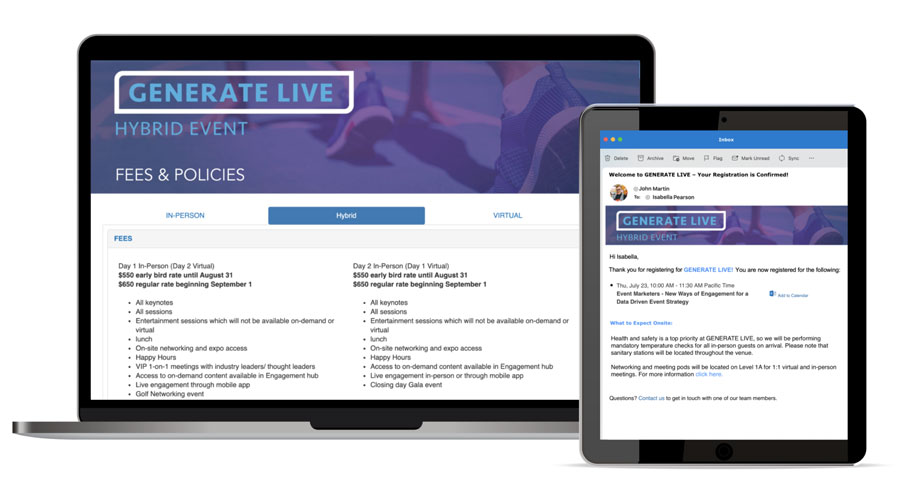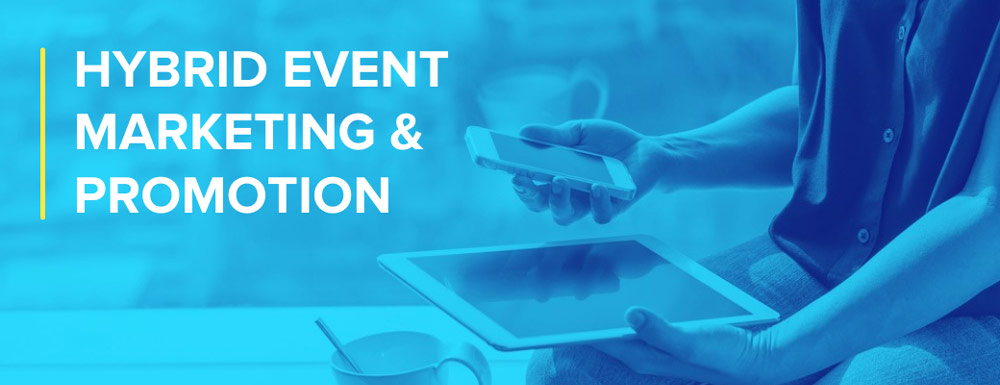Now that we’re all seasoned virtual event pros, reworking our strategies for hybrid event marketing and promotion should come a bit easier, right? Well, not exactly. While all the valuable learnings of your past virtual and in-person event marketing tactics will undoubtedly come into play when planning for hybrid, there are a few additional considerations that have to be factored in when it comes to hybrid event marketing and promotion.
To begin, hybrid events can be an ambiguous concept to attendees who have never attended a hybrid event and are still apprehensive about returning to in-person events. Help to clear up any uncertainty by ensuring that all marketing materials, social posts, and copy on your company website should give participants a clear indication of what to expect from the virtual and in-person experience. Equally important is providing comprehensive safety and social distancing protocols clearly posted on your website and in marketing materials.
Now let’s take a look at some of the tactics to consider throughout the event cycle in order to pull off a winning hybrid event marketing campaign.
Pre-event
Drafting a strategic marketing plan for your hybrid event is the most crucial first step. This will be the blueprint that guides your marketing decisions before, during, and after the event, and should contain a clear timeline for each task that needs to be executed.
To fulfill your plan, start by identifying and prepping your team. Everyone involved with the management and promotion of your event should clearly know their roles and there should be adequate time allowed prior to the event for testing and practice runs. You will also need marketing support specific to running the event; this will include people skilled in audience interaction, managing speakers and sponsors, and providing technical support.
Partnering with your technology provider is one smart way to add technical support to your team if that area is lacking. If budget allows, recruiting the services of an event production company that understands the virtual and hybrid event process can quickly round out your support team and fill in any gaps with less required effort on your part.
At least two or three months before the event launches, establish a virtual command center for your team – be it a Slack channel or project management platform. This will help everyone use a single channel of communication while keeping up with task lists.
Other pre-event marketing and promotion activities you should perform:
- Update your website to include details about your event. Descriptions should clearly depict the expected experience for both in-person and virtual attendees.
- Help to put any potential in-person attendee concerns at ease by offering clear details on health and safety measures that will be in place onsite.
- Publish social media posts and promotional teasers offering early-bird special rates.
- Launch email marketing campaigns to your existing prospect lists and providing lead magnets to entice new opt-ins
- Consider offering sponsors co-branding opportunities with your swag and gifting strategies; this will help offset this particular marketing initiative’s expense.

Build an Event Community
You’ve put in the effort to create an engaging experience for a target audience; as a result, you have a captured group of current or potential customers with a high interest in your brand. Extend the value that both you and your attendees can gain by creating an online community. Social media platforms like LinkedIn make this extremely easy to do.
- Leverage custom hashtags and send direct messages on social networks to create a dialog with attendees leading up to the event.
- Share a custom event background with virtual presenters to use during their session (one that includes your event brand and hashtag). Ask them to take a screenshot with their background and share on social media to help build buzz. For in-person and hybrid events, create Instagram-worthy opportunities (backdrops, installations, headshot services) for attendees to share on social.
- Create a badge in your engagement app for social media shares and posts to your activity feed for added participation. This type of community-building will help to drive greater engagement and activity from your attendees before, during and after the event.
💡
Remember: Interactivity is key when it comes to driving attendee engagement between virtual and in-person audiences. Plan for interaction between guests, speakers and sponsors throughout your event. This will elevate the experience from a passive (and possibly forgettable) event to a memorable and engaging opportunity for attendees to connect.
During the Event
- Ensure that all marketing team members are primed on what to do with check-in data, lead capture, and event engagement data.
- Your event technology platform should segment and sync all data appropriately and send it where it needs to go.
- Encourage the use of gamification in conjunction with engagement apps to gather attendee data. Your engagement app should also be used to gather survey feedback from all attendees, sponsors, and presenters for post-event evaluation and future programming.
- Have a designated social media manager to capture event footage and pictures and share on social media with event-specific hashtags.
- Designate a team member or writer to live-blog during sessions to add to your 365 event content library.
- Distribute swag directly to in-person attendees, and make sure to include virtual attendees in your swag campaign using direct mail or digital gifts.
- Record every event session so that it can be utilized in future marketing.
Post-Event
It’s easy to assume that pre-event activities and tasks conducted during the event are the most vital parts of your marketing strategy; however, post-event activities are just as important, if not more so. Post-event marketing is where you convert warm leads, nurture cooler leads and show all who attended that you appreciate their time and effort.
With post-event marketing, time is of the essence. You want to reach out to attendees while your program is still fresh in their minds. The simplest method of follow-up is sending a “thank you” message to all who attended. If you have exit surveys or polls for your attendees, they can be included with this message as well.
- For additional follow-ups, make sure that your attendees have been broken up into segments so you can hyper-focus your messaging.
- For all attendees, make event sessions available as on-demand content; this will allow you to continue to gather important engagement data.
- Your marketing plan should include a defined schedule for post-event automated and manual follow-up campaigns that integrate with your customer relationship management (CRM) and email marketing service (EMS) platforms.
- Finally, make certain to have a debriefing meeting with your team to discuss what everyone feels went well, and which areas of the marketing strategy could be improved in the future.
Keep in mind that all these efforts will have been made in vein if you don’t have a strong data strategy to capture, manage and act on all the rich buyer and attendee insights that your hybrid event will generate. To learn about hybrid event data strategy and more, check out Certain’s Hybrid Event Strategy Playbook, or contact us for a free consult with one of our event experts.
